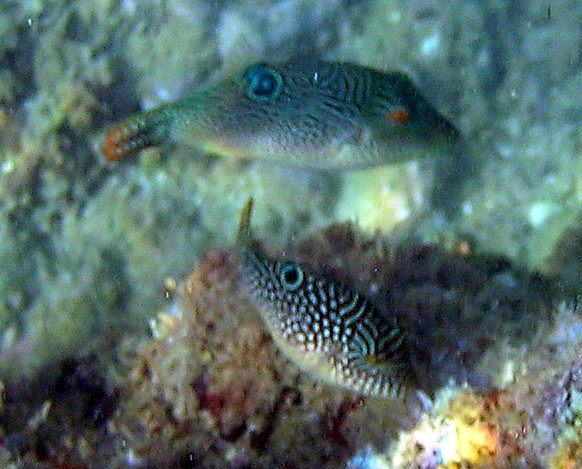zurück Übersicht
Netz-Spitzkopfkugelfisch
zurück
vor


The
Netz-Spitzkopfkugelfisch, known in English as the
Spiny Pufferfish or
Starry Pufferfish (Arothron
hispidus), is a fascinating species of pufferfish that belongs to the
family Tetraodontidae. It is
commonly found in the Indo-Pacific
region, inhabiting tropical and subtropical waters. This species is
known for its distinct appearance and behavior, as well as its ability to
inflate itself when threatened.
Key Features of the
Netz-Spitzkopfkugelfisch (Arothron
hispidus):
1.
Physical Characteristics
-
Appearance: The Netz-Spitzkopfkugelfisch has a robust, round body
with spines covering its
surface, which gives it a spiky appearance. These spines are
hidden beneath the skin and
only become visible when the fish inflates itself.
-
Coloration: This pufferfish
has a light-colored body
with dark spots and a
characteristic starry pattern.
The pattern may vary slightly between individuals but typically resembles a
network of dots, which is where the name "Netz" (meaning "net" in German)
comes from.
-
Size: The species can
grow up to 50 cm (about 19.7
inches) in length, making it one of the larger species of
pufferfish.
2.
Inflation Mechanism
-
Pufferfish Defense: Like
other pufferfish, the Netz-Spitzkopfkugelfisch can inflate its body by
swallowing water (or air, when out of water) to become larger and more
difficult for predators to swallow. The process is a defense mechanism
designed to deter potential predators.
-
Spines: When inflated,
the hidden spines on its body protrude outward, adding to its protection.
These spines are sharp and can cause discomfort or injury to a predator,
discouraging further attacks.
3.
Habitat
-
Tropical and Subtropical Waters:
The Netz-Spitzkopfkugelfisch is commonly found in the
Indo-Pacific region,
specifically around reefs
and shallow coastal areas,
typically at depths of 1 to 50
meters. They prefer coral
reefs or rocky outcrops,
where they can find shelter and food.
-
Distribution: It is
widely distributed in regions including
the Red Sea,
Indian Ocean, and parts
of the Pacific Ocean,
ranging from East Africa
to Japan, and down to
Australia.
4.
Diet
-
Carnivorous: The
Netz-Spitzkopfkugelfisch is a carnivorous pufferfish, primarily feeding on
invertebrates such as
crustaceans (e.g., crabs,
shrimps) and mollusks
(e.g., snails). It has strong jaws capable of cracking open hard shells to
reach the soft tissue inside.
-
Feeding Behavior: This
species is also known to eat some types of
algae and
coral polyps on occasion,
although these are less significant in its diet compared to its carnivorous
tendencies.
5.
Behavior
-
Solitary Nature: Like
many other pufferfish, the Netz-Spitzkopfkugelfisch is typically solitary,
preferring to spend most of its time hiding in cracks and crevices in the
reef or on the sea floor.
-
Slow Movement: Pufferfish
are not fast swimmers, and the Netz-Spitzkopfkugelfisch is no exception.
They tend to move slowly, using their small fins for propulsion and their
tails for steering.
6.
Reproduction
-
Spawning: The
reproductive habits of the Netz-Spitzkopfkugelfisch are not as well-studied
as some other fish species, but like other pufferfish, they likely engage in
external fertilization.
The female lays eggs, and the male fertilizes them externally.
-
Eggs and Larvae: The eggs
are typically laid in sandy or rocky substrates, and once they hatch, the
larvae are planktonic, drifting with ocean currents before they settle into
their adult habitats.
7.
Venom and Toxins
-
Tetrodotoxin: Like many
pufferfish species, the Netz-Spitzkopfkugelfisch contains
tetrodotoxin, a potent
neurotoxin that can be deadly if ingested. The toxin is mainly concentrated
in the fish's liver, ovaries, and skin, making it dangerous to predators and
humans.
-
Caution for Humans: While
this species is not typically consumed in the same way as the fugu
pufferfish in Japan, it still carries the risk of poisoning if not handled
or prepared properly.
8.
Ecological Role
-
Prey and Predator: As a
carnivorous fish, the Netz-Spitzkopfkugelfisch plays an important role in
controlling populations of crustaceans and mollusks in its ecosystem. It
also serves as prey for larger marine predators, such as sharks and large
fish.
-
Reef Health: By feeding
on algae and invertebrates, this pufferfish contributes to the health and
balance of coral reef ecosystems.
9.
Interesting Facts
-
Inflation for Mating: In
addition to using inflation as a defense mechanism, pufferfish may also
inflate during courtship
or to demonstrate strength to potential mates. This behavior can be part of
their mating display.
-
Unique Appearance: The
Netz-Spitzkopfkugelfisch is often regarded as one of the more visually
striking pufferfish species, with its starry pattern and spiky exterior.
-
Lifespan: Moray
pufferfish generally live for about
10 years in the wild,
though their lifespan can be influenced by factors such as food
availability, predation, and habitat conditions.
Conclusion:
The Netz-Spitzkopfkugelfisch (Arothron
hispidus) is a unique and fascinating species of pufferfish that
displays impressive defensive behaviors, including the ability to inflate its
body and reveal spines to deter predators. With its spiny appearance, starry
markings, and carnivorous diet, it is a key player in its reef environment.
While it contains toxins that make it potentially dangerous to humans, its role
in maintaining the balance of the marine ecosystem is significant. Whether
encountered on a dive or in an aquarium, this species is sure to captivate those
with an interest in marine life.
 26.07.25 Copyright Dirk
Rauschenbach Koelnerstrasse 293 51702 Bergneustadt
Datenschutzerklaerung 02261 9788972 Mail ccooly(
at) web.de
26.07.25 Copyright Dirk
Rauschenbach Koelnerstrasse 293 51702 Bergneustadt
Datenschutzerklaerung 02261 9788972 Mail ccooly(
at) web.de
 Safaris
Bergsteigen
Wandern
Inselwandern Weltweit
Safaris
Bergsteigen
Wandern
Inselwandern Weltweit
 Europa
Inselwandern
Europa
Inselwandern
 Städtewandern
Städtewandern
 Paintings
Paintings Dirk Rauschenbach
Dirk Rauschenbach
 Safaris
Bergsteigen
Wandern
Inselwandern Weltweit
Safaris
Bergsteigen
Wandern
Inselwandern Weltweit
 Europa
Inselwandern
Europa
Inselwandern
 Städtewandern
Städtewandern
 Paintings
Paintings Dirk Rauschenbach
Dirk Rauschenbach
![]() 26.07.25 Copyright Dirk
Rauschenbach Koelnerstrasse 293 51702 Bergneustadt
Datenschutzerklaerung 02261 9788972 Mail ccooly(
at) web.de
26.07.25 Copyright Dirk
Rauschenbach Koelnerstrasse 293 51702 Bergneustadt
Datenschutzerklaerung 02261 9788972 Mail ccooly(
at) web.de